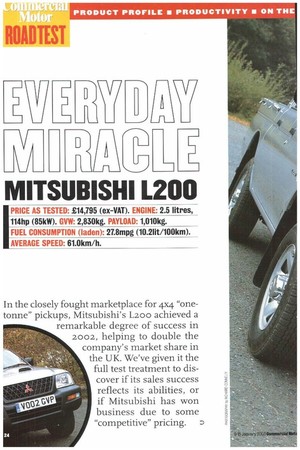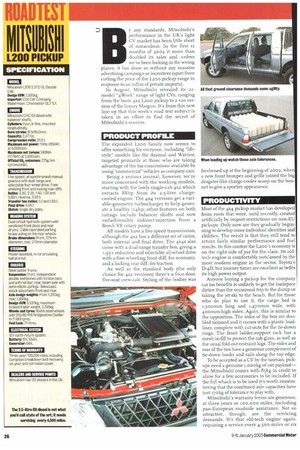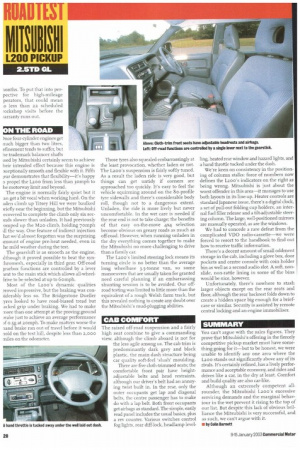MITSUBISHI L200
Page 24

Page 26

Page 28

If you've noticed an error in this article please click here to report it so we can fix it.
IPRICE AS TESTED: £14,795 (ex-VAT). ENGINE: 2.5 litres, 114hp (85kW). GVW: 2,830kg. PAYLOAD: lomkg. FUEL CONSUMPTION (laden): 27.8mpg (10.21it/100km). AVERAGE SPEED: 61.0km/h.
In the closely fought marketplace for 4x4 "onetonne" pickups, Mitsubishi's L200 achieved a remarkable degree of success in 2002, helping to double the company's market share in the UK. We've given it the full test treatment to discover if its sales success reflects its abilities, or if Mitsubishi has won business due to some competitive" pricing. y any standards, Mitsubishi's performance in the UK's light CV market has been little short of miraculous. In the first it months of 2002 it more than doubled its sales and, unless we've been looking in the wrong places, it has done so without any massive advertising campaign or incentives (apart from cutting the price of the 1.200 pickup range in response to an influx of private imports).
In August, Mitsubishi revealed its 2Imodel "4Work" range of light CVs, ranging from the basic 4x2 L200 pickup to a van version of the luxury Shogun. It's from this new line-up that this week's road test subject is taken in an effort to find the secret of Mitsubishi's success.
PRODUCT PROIFILE
The expanded L2oo family now seems to offer something for everyone, including "lifestyle" models like the Animal and Warrior, targeted primarily at those who are taking advantage of the tax concessions available by using "commercial" vehicles as company cars.
Being a serious journal, however, we're more concerned with the working models, starting with the lowly single-cab 4x2 which extracts 88hp from its 2.5-litre chargecooled engine. The 4x4 versions get a variable-geometry turbocharger to help generate a healthy tt4hp; other features on both ratings include balancer shafts and now unfashionable indirect-injection from a Bosch VE rotary pump.
All models have a five-speed transmission, although the 4x2 has a different set of ratios, both internal and final drive. The 4x45 also come with a dual-range transfer box, giving a 1.93:1 reduction and selectable all-wheel drive with a free-wheeling front duff, for economy, and a locking rear diff, for traction.
As well as the standard body (the only choice for 4x2 versions) there's a four-door, five-seat crew-cab. Styling of the bodies was
freshened up at the beginning of 2002, whe a new front bumper and grille joined the bi dragster-like charge-cooler scoop on the bonnet to give a sportier appearance.
PRODUCTIVITY
Most of the 4x4 pickup market has developed from roots that were, until recently, created artificially by import restrictions on non-EU pickups. Only now are they gradually beginning to develop more individual identifies and abilities. The result is that they still tend to return fairly similar performance and fuel results. In this context the L200'S economy is on the right side of par for the class. Its oldtech engine is comfortably outclassed by the most modern engine in the sector, Toyota's D-4D, but journey times are excellent as befits its high power output.
Anyone buying a pickup for the company car tax benefits is unlikely to get the loadspace dirtier than the occasional trip to the dump or taking the jet-ski to the beach. But for those who do plan to use it, the cargo bed is 1,500mm long and 1,47omm wide, with 400mm-high sides. Again, this is similar to the opposition. The sides of the box are doubled skinned and it comes with a plastic loadliner, complete with cut-outs for the tie-down rings. The front ladder-support rack has a mesh in-fill to protect the cab glass, as well as the usual fold-out restraint lugs. The sides and rear of the box have a generous complement of tie-down hooks and rails along the top edge.
To be accepted as a CV by the taxman, pickups need a genuine 1, 000kg of net payload— the Mitsubishi comes with 85kg in credit to allow for a few accessories to be included. If the full whack is to be used it's worth remembering that the combined axle capacities have just 170kg of tolerance to play with.
Mitsubishi's warranty terms are generous, at three years or 100,000 miles, including pan-European roadside assistance. Not so attractive, though, are the servicing demands. It's that old-tech engine again, requiring a service every 4,500 miles or six ionths. To put that into perpective for high-mileage perators, that could mean o less than 22 scheduled rorkshop visits before the rarranty runs out.
)nce four-cylinder engines get nuch bigger than two litres, efinement tends to suffer, but he trademark balancer shafts tsed by Mitsubishi certainly seem to achieve heir intended effect because this engine is xceptionally smooth and flexible with it. Fifth ;ear demonstrates that flexibility—it's happy
o propel the L200 from less than 30mph to he motorway limit and beyond.
The engine is normally fairly quiet but it an get a bit vocal when working hard. On the aden climb up Titsey Hill we were baulked iriefly near the beginning, but the Mitsubishi ecovered to complete the climb only six secrids slower than unladen. It had previously omped up the Mzo climb, holding 70mph 111 the way. One feature of indirect injection hat we'd almost forgotten was the surprising imount of engine pre-heat needed, even in he mild weather during the test.
The gearshift is as smooth as the engine, ilthough it proved possible to beat the syn:hromesh, especially in third gear. Off-road ;earbox functions are controlled by a lever lext to the main stick which allows all-wheelIrive to be selected at up to 6omph.
Most of the L2 00's dynamic qualities roved impressive, but the braking was coniiderably less so. The Bridgestone Dueller :yres looked to have road-biased tread but acked grip under braking. We had to make :nore than one attempt at the proving ground wake just to achieve an average performance 3f o.5g at zomph. To make matters worse the aand brake ran out of travel before it would aold on the test hill, despite less than 2,000 miles on the odometer.
Those tyres also squealed embarrassingly at the least provocation, whether laden or not. The Lzoo's suspension is fairly softly tuned. As a result the laden ride is very good, but things can get untidy if corners are approached too quickly. It's easy to feel the vehicle squirming around on the 8o-profile tyre sidewalls and there's considerable body roll, though not to a dangerous extent. Unladen, the ride is more lively but never uncomfortable. In the wet care is needed if the rear end is not to take charge; the benefits of that easy on-the-move 4x4 selection become obvious on greasy roads as much as off-road. However, when running unladen in the dry everything comes together to make the Mitsubishi no more challenging to drive than a family car.
The L.2.cio's limited steering lock means its turning circle is no better than the average long wheelbase 3.5-tonne van, so some manoeuvres that are usually taken for granted need careful planning if an embarrassing shunting session is to be avoided. Our offroad testing was limited to little more than the equivalent of a rough Welsh farm track, but this revealed nothing to create any doubt over the Mitsubishi's mud-plugging abilities.
CAB COMFORT
The raised off-road suspension and a fairly high seat combine to give a commanding view, although the climb aboard is not for the less agile among us. The cab trim is predominantly dark grey and black plastic, the main dash structure being car quality soft-feel "slush' moulding.
There are five cloth-trimmed seats; the comfortable front pair have heightadjustable belts and head restraints, although our driver's belt had an annoying twist built in. In the rear, only the outer occupants get lap and diagonal belts, the centre passenger has to make do with a lap belt. Both front occupants get airbags as standard. The simple, easily read panel includes the usual basics, plus a rev counter. Various switches control fog lights, rear duff-lock, headlamp level
ling, heated rear window and hazard lights, and a hand throttle tucked under the dash.
We're keen on consistency in the positioning of column stalks: force of numbers now defines the L200'S indicators on the right as being wrong. Mitsubishi is just about the worst offender in this area—it manages to use both layouts in its line-up. Heater controls are standard Japanese issue, there's a digital clock, a set of pull-out folding cup holders, an internal fuel filler release and a tilt-adjustable steering column. The large, well-positioned mirrors are manually operated, as are the windows.
We had to concede a rare defeat from the complicated VDO radio-cassette—we were forced to resort to the handbook to find out how to receive traffic information.
There's a decent amount of small oddment storage in the cab, including a glove box, door pockets and centre console with coin holder bin as well as a second audio slot, A soft, nonslide, non-rattle lining in some of the bins would be nice, however.
Unfortunately, there's nowhere to stash larger objects except on the rear seats and floor, although the rear backrest folds down to create a hidden space big enough for a briefcase or similar. Security is assisted by remote central locking and an engine immobiliser.
SUMMARY
You can't argue with the sales figures. They prove that Mitsubishi's offering in the fiercely competitive pickup market must have something going for it—but to be honest, we were unable to identify any one area where the L200 stands out significantly above any of its rivals. It's certainly refined, has a lively performance and acceptable economy, and rides and drives like a car, in the dry at least. Comfort and build quality are also car-like.
Although an extremely competent allrounder, the Mitsubishi Lzoo's excessive servicing demands and the marginal behaviour in the wet prevent it rising to the top of our list. But despite this lack of obvious brilliance the Mitsubishi is very successful, and as such, we can't argue with it.
• by Cohn Barnett
























































































































































